Hot Solutions for Cool Roofs
Coatings based on PVDF resin have demonstrated the ability to maintain their outstanding balance of properties over several decades - including the ability to optimize cool roof properties by maintaining paint TSR values in Florida exposure tests.
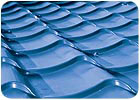
Environmentally friendly, or “green,” building design is becoming increasingly popular in North America. While the green design movement has many different aspects, one of the most attractive components from the building owners’ point of view is the use of “cool roof” technology to dramatically reduce surface roofing temperatures, and thereby reduce building air conditioning costs.1 Research by several national laboratories, as well as other institutions, points to the importance of cool roofs in lowering the energy demand of buildings and mitigating urban heat island effects.
Cities and states across the country are taking note of this development and are incorporating cool roof requirements into their building codes (e.g., California’s Title 24) or offering cool roof incentive programs, often in collaboration with large utility companies. The cool roof concept is also being featured in national green building initiatives, such as the Environmental Protection Agency’s Energy Star program, and in industry programs such as the Cool Metal Roofing Coalition. As a result, the concept of cool roofing is currently one of the hottest topics in the building and construction industries, as well as in related industries such as paint and coatings.
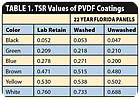
The most weatherable coatings for metal roofing substrates, as well as for other building components, are based on polyvinylidene difluoride (PVDF) resin. The outstanding resistance of these coatings to photochemical degradation leads to excellent gloss and color retention, as well as to chalking resistance.2 The first polymer binder for fluorocarbon architectural coatings was introduced commercially in 1965.3,4 Since then, literally thousands of buildings around the world have been coated with coil or spray paints made with this product. Existing test panels from the 1960s continue to show remarkable color retention after nearly 40 years of South Florida exposure. Most commercial PVDF resin-based paints are sold as non-aqueous dispersion coatings that require a short bake at temperatures of about 230°C (446°F) or higher, so typically they have been applied to metal substrates such as metal coil or aluminum extrusions.
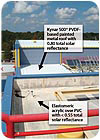 To achieve practical coatings with outstanding weatherability, PVDF paints commonly use the most durable grades of inorganic pigments,5 as well as small quantities of acrylic resin based on monomers such as methyl methacrylate and ethyl acrylate. The acrylic resin is used to improve a few specific properties, such as pigment wetting and coating adhesion, which are difficult to obtain with pure PVDF due to its chemical inertness. The acrylic resins used are thermodynamically miscible with PVDF, so that the coating binder actually has a kind of interpenetrating network (IPN) alloy structure after baking.
To achieve practical coatings with outstanding weatherability, PVDF paints commonly use the most durable grades of inorganic pigments,5 as well as small quantities of acrylic resin based on monomers such as methyl methacrylate and ethyl acrylate. The acrylic resin is used to improve a few specific properties, such as pigment wetting and coating adhesion, which are difficult to obtain with pure PVDF due to its chemical inertness. The acrylic resins used are thermodynamically miscible with PVDF, so that the coating binder actually has a kind of interpenetrating network (IPN) alloy structure after baking.
Because this IPN structure is thermoplastic in nature, thermodynamically stable, and based mainly on the photochemically inert PVDF resin, PVDF resin-based paints have shown the ability to retain their protective and aesthetic properties for decades, even in challenging hot roof environments. This durability is in contrast to conventional crosslinked binder chemistries, such as polyesters, where the combination of sunlight, humidity and temperature - which can easily be 80°C (176°F) or more for a south-facing roof on a hot day - is known to rapidly accelerate the degradation of the crosslinked network, leading to gloss loss, chalking, and potentially the catastrophic failure of the paint.
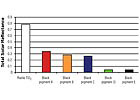
A common measure of the solar reflectivity is the total solar reflectance, or TSR.6 Roughly speaking, the TSR is the fraction of solar energy that is reflected back off the coating. TSR values take into account the energy contained in the full solar spectrum, including the near-infrared region of the spectrum where about half the sun’s radiant energy is contained. Generally speaking, higher TSR values will produce a cooler roof.
These two measures, the emissivity and the TSR, are used in many of the emerging cool roof standards, but the specific requirements vary widely from place to place due to other considerations, including the pitch of the roof and the local climate. There is also a trend toward requiring not only that the initial reflectivity of a coating should meet certain standards, but also that the reflectivity should be maintained over time. For instance, to qualify for the Energy Star label for a low-slope roof surface, the coating’s initial TSR must exceed 0.65 on a scale from 0 to 1, and must be greater than 0.50 after three years. Other programs, such as LEED (Leadership in Energy and Environmental Design, administered by the U.S. Green Building Council), and California’s Title 24, have different requirements.
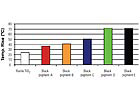 Much of the data used to establish minimum standards for field-exposed coatings was supplied by Dr. W.A. Miller from the Oak Ridge National Laboratories (ORNL).7 Miller and his team analyzed hundreds of test panels representing a wide variety of resin chemistries and pigment types on exposure at various industrial test sites, including a south Florida test site. For polymer coatings, the biggest factor determining the TSR is the grade of pigment that is used in the topcoat. However, recent research has shown that there are contributions to the TSR from the primer and pre-treatment used, and also from the polymer binder used in the topcoat.8
Much of the data used to establish minimum standards for field-exposed coatings was supplied by Dr. W.A. Miller from the Oak Ridge National Laboratories (ORNL).7 Miller and his team analyzed hundreds of test panels representing a wide variety of resin chemistries and pigment types on exposure at various industrial test sites, including a south Florida test site. For polymer coatings, the biggest factor determining the TSR is the grade of pigment that is used in the topcoat. However, recent research has shown that there are contributions to the TSR from the primer and pre-treatment used, and also from the polymer binder used in the topcoat.8
The ORNL studies revealed that the oldest of the historic test panels coated with PVDF-based paints retained more than 90% of their reflectivity even after decades of Florida exposure. Table 1 shows some representative results, including results for dark-colored (low TSR) paints, which would be expected to have a much more severe heat history.
Dirt pickup and algae growth, of course, can substantially reduce the “cool roof” properties of paints made with conventional resins, such as elastomeric acrylics.9 Figure 1 illustrates this dirt pickup problem for white test roofs after nine years in Florida. The elastomeric acrylic roof paint picked up so much dirt that the TSR dropped below 0.50, while the PVDF-based paint was much whiter and had a TSR of 0.80.

From Figure 2, it can be seen that the white coating has a much higher TSR than any of the black coatings (not surprisingly, since the black coatings absorb solar energy in the visible part of the spectrum). However, it is also apparent that certain black pigment grades have a substantially higher TSR than others. This disparity is due to large differences in the pigment reflectivity in the near infrared region of the solar energy spectrum. Similar differences are observed with other color families as well. For each color of interest, the pigment grades with the highest TSR would be most suitable for use in “cool roof” applications - provided, of course, that the pigment itself is sufficiently weatherable. For this reason, higher quality roof coatings are almost exclusively made with the most durable inorganic pigment grades. This formulation choice ensures good long term color stability, as long as the coating binder itself is also sufficiently stable.
 Because black coatings absorb so much solar energy in the visible region, they potentially show the biggest benefit from the use of higher TSR pigment grades in terms of reduced heat buildup. Figure 3 shows the measured temperature rise for the set of coatings described in Figure 2, when placed in an infrared light box (simulating what occurs in direct sunlight on a rooftop). For the higher TSR black pigments, the temperature rise is only a little higher than that observed for the white control panel. Conversely, for low TSR black pigments, the temperature rise in the IR light box is about 70°C (158°F) - nearly hot enough to boil water.
Because black coatings absorb so much solar energy in the visible region, they potentially show the biggest benefit from the use of higher TSR pigment grades in terms of reduced heat buildup. Figure 3 shows the measured temperature rise for the set of coatings described in Figure 2, when placed in an infrared light box (simulating what occurs in direct sunlight on a rooftop). For the higher TSR black pigments, the temperature rise is only a little higher than that observed for the white control panel. Conversely, for low TSR black pigments, the temperature rise in the IR light box is about 70°C (158°F) - nearly hot enough to boil water.
Researchers also measured the TSR for a series of waterborne test paints in different tint shades using a new latex technology platform based on PVDF resin technology.10 The test panels had been on exposure in Florida for five to six years at the time of the analysis. Regardless of color, the typical loss of reflectance for these coatings was found to be on the order of 3% for unwashed panels, and even lower if the panels were lightly washed (see Table 2). The color and gloss retention were also excellent. Based on this data, it should be possible to meet cool roof requirements in most parts of the country, including requirements for TSR retention, using a variety of pastel and earth-tone colors.
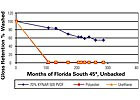
To systematically probe the binder effect on TSR, researchers prepared a series of tint blue coatings at the same pigment volume concentration but varying the ratio of PVDF to acrylic resin in the coating binder. The resulting paints were then cast on chromated aluminum AA3003 substrates using wire-wrapped draw down rods, and baked to obtain a series of panels for each paint at varying dry film thicknesses. Figure 5 shows the TSR values measured for these coatings as a function of thickness and PVDF content. The increase in TSR with increasing PVDF content level can be clearly seen. There is also an improvement in TSR for thicker coatings.
 To better understand the resin-dependence of the TSR, the specular reflectance of the films at 1.4 mils dry film thickness was measured as function of wavelength, using a UV-VIS-NIR Spectrometer with an integrating sphere (Perkin-Elmer Lambda 19). Figure 6 shows the results. Little difference existed in the visible reflectance between these films, but the relatively higher reflectance in the near infrared (0.7 to 2.5 μm) of the pure PVDF resin-based coating yielded a higher overall solar reflectance.
To better understand the resin-dependence of the TSR, the specular reflectance of the films at 1.4 mils dry film thickness was measured as function of wavelength, using a UV-VIS-NIR Spectrometer with an integrating sphere (Perkin-Elmer Lambda 19). Figure 6 shows the results. Little difference existed in the visible reflectance between these films, but the relatively higher reflectance in the near infrared (0.7 to 2.5 μm) of the pure PVDF resin-based coating yielded a higher overall solar reflectance.
In more recent work, researchers have noted TSR improvements of a similar magnitude when comparing latex paints made with 70% PVDF and color-matched acrylic latex paints. A boost in TSR of several percent would be large enough to allow “marginal” colors to meet the requirements of various cool roof standards, including the California Title 24 regulations - thereby expanding the color palette for after-market roof coatings.

In order to get “self-cleaning” or “dirt-shedding” properties, the most common technical approach is to create a hydrophilic coating surface.11 The hydrophilic surface is thought to reduce the adhesive interaction between dirt particles and the paint film, while being easily wetted by dew and rain. This effect allows the rain to dislodge dirt particles from the surface, with the rain water sheeting off the surface and not leaving water spots. Since the bulk coating binder normally needs to be hydrophobic in order to contribute barrier properties, the dirt-shedding component is commonly an additive. The additive should ideally concentrate at the coating surface as the paint is drying; this means it needs to be somewhat incompatible with the coating binder, with a low surface energy and a relatively high mobility. Certain silicon-based products are commonly used as additives, e.g. particular alkoxysilanes, or methyl or ethyl silicates. The idea is that these materials will migrate to the coating surface as the paint is drying; then, once they are at the surface, the alkoxy groups will hydrolyze, leaving a hydrophilic surface.
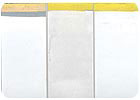 For these surface additives to work effectively, the proper control of the migration and hydrolysis rates are crucial to achieving dirt shedding performance. Since the additives are hydrolytically sensitive materials, any hydrolysis and condensation crosslinking reactions that occur in the wet paint can prevent additives from migrating into the surface during baking, hindering generation of a more hydrolytic surface. If the hydrolysis rate is too fast, the paint effectively develops a short pot life due to these in-can reactions. Conversely, if the hydrolysis rate at the surface is too slow, the paint is slow to develop a hydrophilic surface, and it does not have good dirt shedding. In practice, because of these conflicting hydrolysis rate requirements, typical commercial dirt-shedding coatings often have had an effective pot life of only about 24 hours after the addition of the dirt-shedding additive. After this time period, a loss of both dirt shedding ability and gloss occurs.
For these surface additives to work effectively, the proper control of the migration and hydrolysis rates are crucial to achieving dirt shedding performance. Since the additives are hydrolytically sensitive materials, any hydrolysis and condensation crosslinking reactions that occur in the wet paint can prevent additives from migrating into the surface during baking, hindering generation of a more hydrolytic surface. If the hydrolysis rate is too fast, the paint effectively develops a short pot life due to these in-can reactions. Conversely, if the hydrolysis rate at the surface is too slow, the paint is slow to develop a hydrophilic surface, and it does not have good dirt shedding. In practice, because of these conflicting hydrolysis rate requirements, typical commercial dirt-shedding coatings often have had an effective pot life of only about 24 hours after the addition of the dirt-shedding additive. After this time period, a loss of both dirt shedding ability and gloss occurs.
Researchers have recently been able to dramatically improve this situation by identifying effective water scavengers that can be added to the formulation.12 These materials appear to be effective in preventing premature hydrolysis and condensation reactions in the wet paint, preserving the ability of the additives to migrate to the surface during baking to produce a hydrophilic surface.
With this technology, a working pot life of well over one month has been demonstrated for dirt-shedding coatings made with PVDF. Figure 7 and Table 4 show the effectiveness of this solution in white paints exposed for five months in Singapore (45 degrees south-facing). After five months exposure, a standard 70% PVDF formulation picked up a considerable amount of dirt (ΔE = 10), while the dirt-shedding formulations picked up almost no dirt (ΔE <2) and had no loss of gloss. The same dirt-shedding properties were achieved whether the paint was applied one day after the addition of the dirt-shedding additive, or 30 days after the additive was added to the formulation. After five months of exposure, a standard PVDF formulation demonstrated a considerable reflectance reduction (up to 15%), while both the fresh and aged formulations with the invention had only 1% reflectance loss in this extremely challenging environment.


Environmentally friendly, or “green,” building design is becoming increasingly popular in North America. While the green design movement has many different aspects, one of the most attractive components from the building owners’ point of view is the use of “cool roof” technology to dramatically reduce surface roofing temperatures, and thereby reduce building air conditioning costs.1 Research by several national laboratories, as well as other institutions, points to the importance of cool roofs in lowering the energy demand of buildings and mitigating urban heat island effects.
Cities and states across the country are taking note of this development and are incorporating cool roof requirements into their building codes (e.g., California’s Title 24) or offering cool roof incentive programs, often in collaboration with large utility companies. The cool roof concept is also being featured in national green building initiatives, such as the Environmental Protection Agency’s Energy Star program, and in industry programs such as the Cool Metal Roofing Coalition. As a result, the concept of cool roofing is currently one of the hottest topics in the building and construction industries, as well as in related industries such as paint and coatings.

Total solar reflectance values of KYNAR 500®PVDF based coatings before and after 22 years of Florida weathering (south 45°).
The PVDF Advantage
Most conventional roofing materials absorb some amount of solar radiation, causing a rise in surface temperature. This heat not only can be transferred to the interior of the building, but it also accelerates the deterioration of the roofing materials. Effective long-term cool roofing approaches must address both of these problems - they must substantially lower the temperature of the roofing surface on hot days, and they must retain the ability to do so over a long service life, ideally with minimal maintenance.The most weatherable coatings for metal roofing substrates, as well as for other building components, are based on polyvinylidene difluoride (PVDF) resin. The outstanding resistance of these coatings to photochemical degradation leads to excellent gloss and color retention, as well as to chalking resistance.2 The first polymer binder for fluorocarbon architectural coatings was introduced commercially in 1965.3,4 Since then, literally thousands of buildings around the world have been coated with coil or spray paints made with this product. Existing test panels from the 1960s continue to show remarkable color retention after nearly 40 years of South Florida exposure. Most commercial PVDF resin-based paints are sold as non-aqueous dispersion coatings that require a short bake at temperatures of about 230°C (446°F) or higher, so typically they have been applied to metal substrates such as metal coil or aluminum extrusions.

Figure 1. Dirt pickup of white roofs after nine years of field exposure in Florida.
Because this IPN structure is thermoplastic in nature, thermodynamically stable, and based mainly on the photochemically inert PVDF resin, PVDF resin-based paints have shown the ability to retain their protective and aesthetic properties for decades, even in challenging hot roof environments. This durability is in contrast to conventional crosslinked binder chemistries, such as polyesters, where the combination of sunlight, humidity and temperature - which can easily be 80°C (176°F) or more for a south-facing roof on a hot day - is known to rapidly accelerate the degradation of the crosslinked network, leading to gloss loss, chalking, and potentially the catastrophic failure of the paint.

Figure 2. Total solar reflectance of KYNAR 500 PVDF resin-based paints as a function of the pigment grade used.
Total Solar Reflectance and Cool Roof Technology
Two key physical properties largely determine how much heat builds up on a surface exposed to solar radiation: emissivity and reflectivity. The emissivity is a measure of the ability of a hot object to radiate away heat. It is generally low (unfavorable) for bare metals and high (favorable) for all kinds of polymer coatings, including PVDF coatings. The reflectivity - the extent to which radiative energy is reflected away/scattered rather than absorbed - depends on many factors that are under the control of the paint formulator and applicator.A common measure of the solar reflectivity is the total solar reflectance, or TSR.6 Roughly speaking, the TSR is the fraction of solar energy that is reflected back off the coating. TSR values take into account the energy contained in the full solar spectrum, including the near-infrared region of the spectrum where about half the sun’s radiant energy is contained. Generally speaking, higher TSR values will produce a cooler roof.
These two measures, the emissivity and the TSR, are used in many of the emerging cool roof standards, but the specific requirements vary widely from place to place due to other considerations, including the pitch of the roof and the local climate. There is also a trend toward requiring not only that the initial reflectivity of a coating should meet certain standards, but also that the reflectivity should be maintained over time. For instance, to qualify for the Energy Star label for a low-slope roof surface, the coating’s initial TSR must exceed 0.65 on a scale from 0 to 1, and must be greater than 0.50 after three years. Other programs, such as LEED (Leadership in Energy and Environmental Design, administered by the U.S. Green Building Council), and California’s Title 24, have different requirements.

Figure 3. Measured temperature rise of KYNAR 500 PVDF resin-based paints in IR light box.
The ORNL studies revealed that the oldest of the historic test panels coated with PVDF-based paints retained more than 90% of their reflectivity even after decades of Florida exposure. Table 1 shows some representative results, including results for dark-colored (low TSR) paints, which would be expected to have a much more severe heat history.
Dirt pickup and algae growth, of course, can substantially reduce the “cool roof” properties of paints made with conventional resins, such as elastomeric acrylics.9 Figure 1 illustrates this dirt pickup problem for white test roofs after nine years in Florida. The elastomeric acrylic roof paint picked up so much dirt that the TSR dropped below 0.50, while the PVDF-based paint was much whiter and had a TSR of 0.80.

Total solar reflectance values of tint paints based on KYNAR AQUATECTM latex before and after five years of Florida weathering.
Pigment Effect on Cool Roof Properties
As mentioned previously, the choice of pigment has a significant effect on the TSR value of roof coatings. This effect is illustrated in Figure 2, which shows the TSR values for a set of coil paints made with a PVDF resin, along with different metal oxide pigment grades.From Figure 2, it can be seen that the white coating has a much higher TSR than any of the black coatings (not surprisingly, since the black coatings absorb solar energy in the visible part of the spectrum). However, it is also apparent that certain black pigment grades have a substantially higher TSR than others. This disparity is due to large differences in the pigment reflectivity in the near infrared region of the solar energy spectrum. Similar differences are observed with other color families as well. For each color of interest, the pigment grades with the highest TSR would be most suitable for use in “cool roof” applications - provided, of course, that the pigment itself is sufficiently weatherable. For this reason, higher quality roof coatings are almost exclusively made with the most durable inorganic pigment grades. This formulation choice ensures good long term color stability, as long as the coating binder itself is also sufficiently stable.

Total solar reflectance values of color-matched orange paints based on different resin chemistries before and after 22 years of Florida weathering.
Researchers also measured the TSR for a series of waterborne test paints in different tint shades using a new latex technology platform based on PVDF resin technology.10 The test panels had been on exposure in Florida for five to six years at the time of the analysis. Regardless of color, the typical loss of reflectance for these coatings was found to be on the order of 3% for unwashed panels, and even lower if the panels were lightly washed (see Table 2). The color and gloss retention were also excellent. Based on this data, it should be possible to meet cool roof requirements in most parts of the country, including requirements for TSR retention, using a variety of pastel and earth-tone colors.

Figure 4. The gloss retention of color-matched orange paints based on different resin chemistries as function of Florida weathering.
Binder Effect on Cool Roof Properties
As noted previously, recent research has shown that there are contributions to the TSR from the primer and pre-treatment used, and also from the polymer binder used in the topcoat. An example of the polymer binder effect can be seen in Table 3 for a series of color-matched orange paints based on different resin chemistries, which had been on exposure in Florida (45 degrees south-facing) for 22 years.6 The table shows that the paint with 70% PVDF resin had an advantage in TSR over the other paints for the unexposed part of the coating. This advantage was maintained after exposure - and even increased compared to the polyester, although the polyester might have been expected to increase in TSR due to its heavy chalking. Figure 4 shows the gloss retention of these same panels as a function of Florida weathering. Both the urethane and polyester had completely lost gloss at about 10 years of Florida weathering. (Earlier gloss data is not available for this series.) The panel with 70% PVDF lost less than 15% gloss after 10 years of weathering, and the gloss retention was more than 55% even after 22 years of Florida exposure.To systematically probe the binder effect on TSR, researchers prepared a series of tint blue coatings at the same pigment volume concentration but varying the ratio of PVDF to acrylic resin in the coating binder. The resulting paints were then cast on chromated aluminum AA3003 substrates using wire-wrapped draw down rods, and baked to obtain a series of panels for each paint at varying dry film thicknesses. Figure 5 shows the TSR values measured for these coatings as a function of thickness and PVDF content. The increase in TSR with increasing PVDF content level can be clearly seen. There is also an improvement in TSR for thicker coatings.

Figure 5. Total solar reflectance value as a function of PVDF level for a series of tint blue coatings at a constant pigment volume concentration.
In more recent work, researchers have noted TSR improvements of a similar magnitude when comparing latex paints made with 70% PVDF and color-matched acrylic latex paints. A boost in TSR of several percent would be large enough to allow “marginal” colors to meet the requirements of various cool roof standards, including the California Title 24 regulations - thereby expanding the color palette for after-market roof coatings.

Figure 6. The specular reflectance of films 1.4 mils thick as function of wavelength, measured with a UV-VIS-NIR Spectrometer with an integrating sphere.
Maintaining High Reflectivity by Resisting Dirt Pickup
To satisfy regulatory requirements and ensure energy efficiency, light-colored, high-TSR roofs should maintain their reflectivity over many years. For this reason, roof coatings must resist dirt pickup. In relatively clean exposure environments, such as south Florida, test panels featuring PVDF-based paints have been found to lose at most only a few percent reflectance even after many years of exposure. But it is well known that many Asian cities present a more severe challenge in terms of dirt pickup. Fortunately, some new developments in “stay clean” technology, which are aimed at enhancing the dirt-shedding properties of PVDF coatings, also seem to be effective in maintaining TSR values.In order to get “self-cleaning” or “dirt-shedding” properties, the most common technical approach is to create a hydrophilic coating surface.11 The hydrophilic surface is thought to reduce the adhesive interaction between dirt particles and the paint film, while being easily wetted by dew and rain. This effect allows the rain to dislodge dirt particles from the surface, with the rain water sheeting off the surface and not leaving water spots. Since the bulk coating binder normally needs to be hydrophobic in order to contribute barrier properties, the dirt-shedding component is commonly an additive. The additive should ideally concentrate at the coating surface as the paint is drying; this means it needs to be somewhat incompatible with the coating binder, with a low surface energy and a relatively high mobility. Certain silicon-based products are commonly used as additives, e.g. particular alkoxysilanes, or methyl or ethyl silicates. The idea is that these materials will migrate to the coating surface as the paint is drying; then, once they are at the surface, the alkoxy groups will hydrolyze, leaving a hydrophilic surface.

Figure 7. Panels after five months of Singapore exposure, unwashed (left to right): KYNAR 500 PVDF-based white paint (dirt shedding invention), one-day-old formulation (i.e., one day after adding dirt shedding additive); control white paint without dirt shedding additive; KYNAR 500 PVDF-based white paint (dirt shedding invention), 30-day-old formulation.
Researchers have recently been able to dramatically improve this situation by identifying effective water scavengers that can be added to the formulation.12 These materials appear to be effective in preventing premature hydrolysis and condensation reactions in the wet paint, preserving the ability of the additives to migrate to the surface during baking to produce a hydrophilic surface.
With this technology, a working pot life of well over one month has been demonstrated for dirt-shedding coatings made with PVDF. Figure 7 and Table 4 show the effectiveness of this solution in white paints exposed for five months in Singapore (45 degrees south-facing). After five months exposure, a standard 70% PVDF formulation picked up a considerable amount of dirt (ΔE = 10), while the dirt-shedding formulations picked up almost no dirt (ΔE <2) and had no loss of gloss. The same dirt-shedding properties were achieved whether the paint was applied one day after the addition of the dirt-shedding additive, or 30 days after the additive was added to the formulation. After five months of exposure, a standard PVDF formulation demonstrated a considerable reflectance reduction (up to 15%), while both the fresh and aged formulations with the invention had only 1% reflectance loss in this extremely challenging environment.

Retention of properties of white 70% PVDF resin-based coatings with and without the dirt shedding additive after five months of Singapore exposure.
Keeping Their Cool
Architectural coatings containing at least 70 wt% PVDF have demonstrated the ability to maintain their outstanding balance of properties over several decades - including the ability to optimize cool roof properties by maintaining paint TSR values in Florida exposure tests. Coatings with high PVDF levels also appear to have a small but reproducible advantage in TSR compared to other resin chemistries. By using newly developed effective dirt-shedding approaches, these high TSR values can be maintained over the long term, even in dirty urban environments.Links
Looking for a reprint of this article?
From high-res PDFs to custom plaques, order your copy today!




